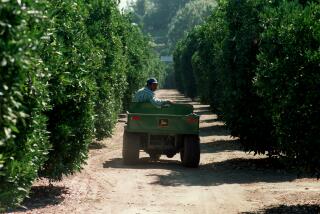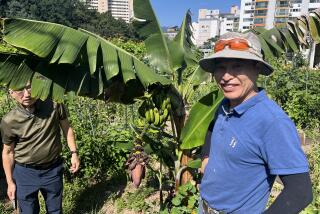Banana Boom : Warm ‘Microclimate’ Makes Tropical Fruit Thrive on Southland Plantation
- Share via
Along U.S. 101 near the Ventura-Santa Barbara county line lies a small tropical paradise that for years has astonished weather analysts and farmers.
Tucked between the ocean and 300-foot-high bluffs is a place called La Conchita, a seaside community that is also the home of the only commercial banana plantation in the continental United States, according to the International Banana Assn.
There, 10,000 banana trees are fanned by balmy ocean breezes, basking in an island of frost-free weather. When Ventura freezes over, the Seaside Banana Farm is frost-free. When Santa Barbara shivers, bananas at the 12-acre plantation ripen on the stalk.
One of the managers of the tiny banana republic is Doug Richardson, 41, an occasional landscaper who began cultivating bananas six years ago as an experiment in his front yard. He found the banana plants he was growing for ground cover actually were producing tasty fruit. In 1985, he decided to grow them commercially.
Richardson said that up until then, growing bananas “was unheard of in this state.”
A geography major at UC Santa Barbara, Richardson researched temperatures in countries where bananas are grown.
“What I discovered is that we have a unique climate here,” he said.
During the next few months of summer, the plantation will enjoy hothouse temperatures hovering between 85 and 95 degrees.
Richardson’s partner, Paul Turner, 43, said he was a skeptical at first. But old-timers told him they had never seen a frost in La Conchita. Then he learned that the plantation has higher temperatures than the Canary Islands off the coast of Africa. “I figured that if they can do it there, we could do it too,” Turner said.
The farm produces 10 to 20 tons of bananas per acre every year, compared to 25 to 30 tons on other plantations. Two years ago, the two were quoted as saying that they hoped to gross about $200,000. But today Richardson and Turner are more circumspect about what they garner from nearly a quarter of a million pounds of bananas sold every year.
Agricultural officials and other farmers acknowledged that the plantation is an environmental oddity.
“I tried to grow bananas on the Oxnard Plain and they froze,” said Rob Brokaw, a grower who also specializes in rare and exotic fruits.
The plantation does well in the winter because the ocean--with its temperate currents only a few hundred yards away--maintains a moderate temperature, said Bob Brendler, an adviser with University of California Cooperative Extension.
The moderate air coming off the ocean moves up the area’s steep slopes, breaking up any stagnant, freezing air. In summer, ocean breezes bathe the area with cool, humid air, mimicking the climate of the tropics.
Richardson and Turner admit that their La Conchita plantation is not the only hot spot in the county. Bananas are grown in Carpinteria, about five miles away, but the crop is much smaller.
Robert Moore, top banana of the International Banana Assn., called the farm a “climatic nonconformity.”
Banana plantations usually are located in subtropical climates where the temperatures rarely dip below 55 degrees, Moore said. Banana farming was previously thought impossible in California, away from the porous volcanic soil that plants favor, he said. But Seaside Banana Farm has changed his mind. “It’s a very unusual spot,” he said.
Some of the farm’s success goes beyond climatological luck. The farm requires intensive care. Instead of relying on tropical rainfall, the two farmers planted drought-resistant banana tubers and lined the groves with black irrigation pipes.
Every stalk of bananas is covered with a blue plastic bag to speed the ripening process and prevent damage from leaves. Each banana tree is hand-cultivated by a hired crew of six workers and small trees are placed in pots.
At $1 to $4 a pound, the bananas are not cheap. They are sold to organic food stores and pricey restaurants across the country.
Richardson and Turner say that one of their plans is to turn the plantation into a roadside attraction where a guide would conduct 20-minute tours through the groves, explaining the origin of banana plants.
But neither Richardson nor Turner want to turn their plantation into a tropical Knott’s Berry Farm. “It could become an A-1 tourist trap,” Turner said.
“We’re occupied in our farm,” Richardson said. “We’re just down and dirty farmers.”
More to Read
Sign up for Essential California
The most important California stories and recommendations in your inbox every morning.
You may occasionally receive promotional content from the Los Angeles Times.










